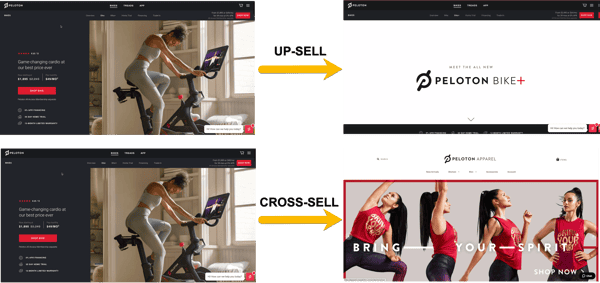5 SEO Insights From Google's Helpful Content Update
Google has made several big updates to how their search algorithm works over the past two years. However, few updates have created as much panic and...

To some, the differences between cross-selling and up-selling may seem hazy, as both strategies do share some similarities. However, the following example should make those differences a little clearer.

Up-selling encourages a customer to purchase a more expensive model in the same product family or add features to the original product. To illustrate, someone looking at a low-end, belt clip Fitbit may be up-sold to purchase the higher-end model with heart rate monitoring, and other enhanced features.
Alternatively, cross-selling is a selling technique that prompts a customer to supplement his or her initial purchase with complementary products. You’ve probably experienced this on Amazon with their successful “frequently bought together” recommendations on product pages. In the example above, someone that has purchased the higher-end fitness tracker may also be interested in the Wi-Fi connected scale that pairs with their shiny, new Fitbit.
Cross-selling and up-selling are fundamental elements of every marketing plan. After all, it is more cost-effective than acquiring new customers, promotes customer retention, and the products required to create a successful cross-selling strategy are usually already in place.
Unfortunately, many cross-selling and up-selling efforts fail in their strategy; specifically, customer intelligence and segmentation. In fact, a Harvard Business School study showed that one-in-five cross-buying customers are unprofitable, accounting for 70% of a company’s customer loss. Therefore, the key to successful cross-selling and up-selling is knowing where your best opportunities are and investing in the right activities to maximize those opportunities.
Central to this process is the development and use of consumer personas. Understanding what drives your existing customers, and how to segment them according to their product needs and usage will allow you to identify the best cross-sell opportunities while also helping you avoid potentially unproductive segments. These unproductive segments could be groups that tend to overuse customer service, limit their spending, or only take advantage of steep incentives or promotions.
Once you identify which segments are most valuable to your business, it is important to understand the market penetration of your products. This will help you set a benchmark for realistic and measurable campaign goals. Your market penetration number compares the current vs. potential demand for your products and services and is a measure of the opportunities available through various tactics, including cross-selling and up-selling.
Equally important to having the right products for a cross-selling or up-selling campaign is having effective content to fuel the campaign. To be successful, you must deliver a steady stream of content and tools that lead your customers down an incremental path to continuous conversion. In each instance, this involves content that is relevant to the customer, based on data, knowledge of their behavior, and their stage in their consumer decision journey. The objective of this content is to keep the communication channels with consumers active until they are ready to act. The key to cross-selling is fully understanding each of your customer segments and delivering relevant content, at scale, to provide compelling interactions.
Up-selling not only results in larger orders and more revenue but also increased customer satisfaction. Customers appreciate when you make relevant and useful recommendations. It's for this reason that an essential channel for up-selling may be your customer support group. By broadening your marketing focus to include customer service and customer support channels, you are potentially unlocking some of your greatest up-selling and cross-selling opportunities via after-sale service and first-rate customer support.
At face value, these tactics may appear simple to implement, however without an initial investment in the right strategy and product mix, even the best cross-selling and up-selling campaigns may fail. It's only by starting with the data, and a willingness to test and optimize your campaigns, that you will see immediate and powerful results.
Sign up for our monthly newsletter to receive updates.

Google has made several big updates to how their search algorithm works over the past two years. However, few updates have created as much panic and...

As companies grow, they typically evolve into needing sub-brands. A sub-brand is simply a division or subsidiary of an existing brand.

AI-powered search is rewriting the rules of digital visibility. With the rise of AI Overviews (AIOs), rich snippets that provide immediate,...